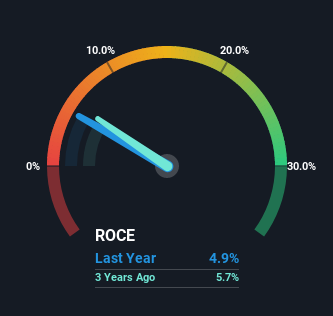- United States
- /
- Luxury
- /
- OTCPK:CTHR
Investors Will Want Charles & Colvard's (NASDAQ:CTHR) Growth In ROCE To Persist
What trends should we look for it we want to identify stocks that can multiply in value over the long term? Typically, we'll want to notice a trend of growing return on capital employed (ROCE) and alongside that, an expanding base of capital employed. Basically this means that a company has profitable initiatives that it can continue to reinvest in, which is a trait of a compounding machine. Speaking of which, we noticed some great changes in Charles & Colvard's (NASDAQ:CTHR) returns on capital, so let's have a look.
What Is Return On Capital Employed (ROCE)?
If you haven't worked with ROCE before, it measures the 'return' (pre-tax profit) a company generates from capital employed in its business. Analysts use this formula to calculate it for Charles & Colvard:
Return on Capital Employed = Earnings Before Interest and Tax (EBIT) ÷ (Total Assets - Current Liabilities)
0.049 = US$3.1m ÷ (US$69m - US$6.8m) (Based on the trailing twelve months to June 2022).
Therefore, Charles & Colvard has an ROCE of 4.9%. In absolute terms, that's a low return and it also under-performs the Luxury industry average of 15%.
View our latest analysis for Charles & Colvard

Above you can see how the current ROCE for Charles & Colvard compares to its prior returns on capital, but there's only so much you can tell from the past. If you'd like to see what analysts are forecasting going forward, you should check out our free report for Charles & Colvard.
What Can We Tell From Charles & Colvard's ROCE Trend?
We're delighted to see that Charles & Colvard is reaping rewards from its investments and is now generating some pre-tax profits. About five years ago the company was generating losses but things have turned around because it's now earning 4.9% on its capital. Not only that, but the company is utilizing 78% more capital than before, but that's to be expected from a company trying to break into profitability. We like this trend, because it tells us the company has profitable reinvestment opportunities available to it, and if it continues going forward that can lead to a multi-bagger performance.
What We Can Learn From Charles & Colvard's ROCE
Overall, Charles & Colvard gets a big tick from us thanks in most part to the fact that it is now profitable and is reinvesting in its business. Investors may not be impressed by the favorable underlying trends yet because over the last five years the stock has only returned 28% to shareholders. So exploring more about this stock could uncover a good opportunity, if the valuation and other metrics stack up.
Charles & Colvard does have some risks though, and we've spotted 3 warning signs for Charles & Colvard that you might be interested in.
While Charles & Colvard isn't earning the highest return, check out this free list of companies that are earning high returns on equity with solid balance sheets.
New: AI Stock Screener & Alerts
Our new AI Stock Screener scans the market every day to uncover opportunities.
• Dividend Powerhouses (3%+ Yield)
• Undervalued Small Caps with Insider Buying
• High growth Tech and AI Companies
Or build your own from over 50 metrics.
Have feedback on this article? Concerned about the content? Get in touch with us directly. Alternatively, email editorial-team (at) simplywallst.com.
This article by Simply Wall St is general in nature. We provide commentary based on historical data and analyst forecasts only using an unbiased methodology and our articles are not intended to be financial advice. It does not constitute a recommendation to buy or sell any stock, and does not take account of your objectives, or your financial situation. We aim to bring you long-term focused analysis driven by fundamental data. Note that our analysis may not factor in the latest price-sensitive company announcements or qualitative material. Simply Wall St has no position in any stocks mentioned.
About OTCPK:CTHR
Charles & Colvard
Operates as a fine jewelry company in the United States and internationally.
Excellent balance sheet with low risk.
Similar Companies
Market Insights
Community Narratives



